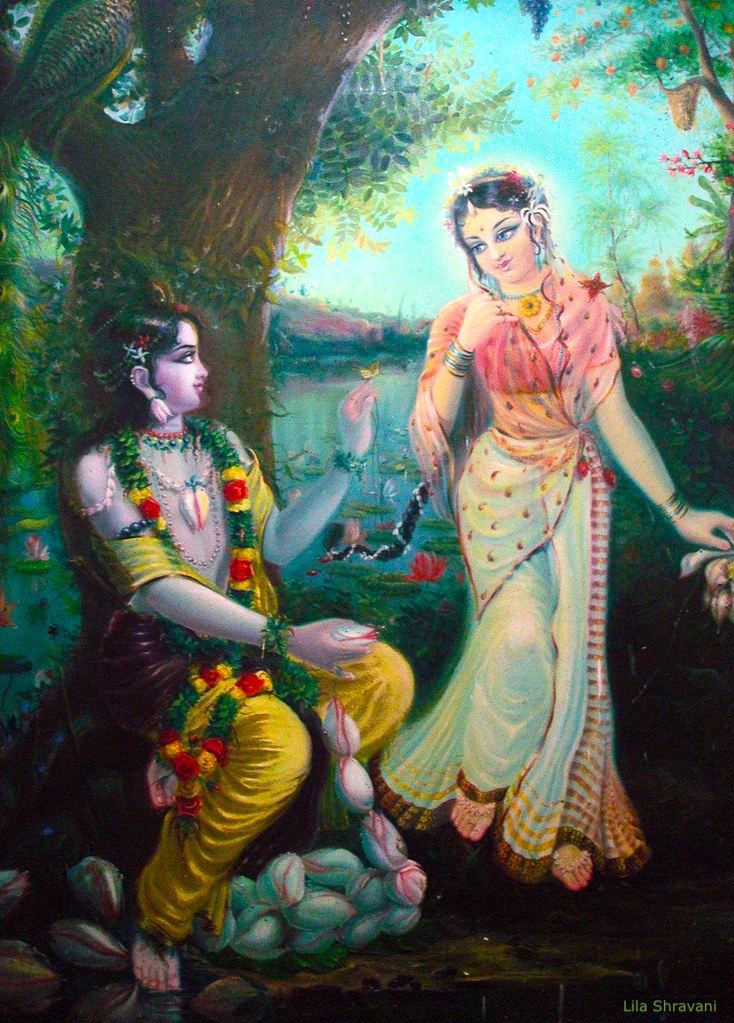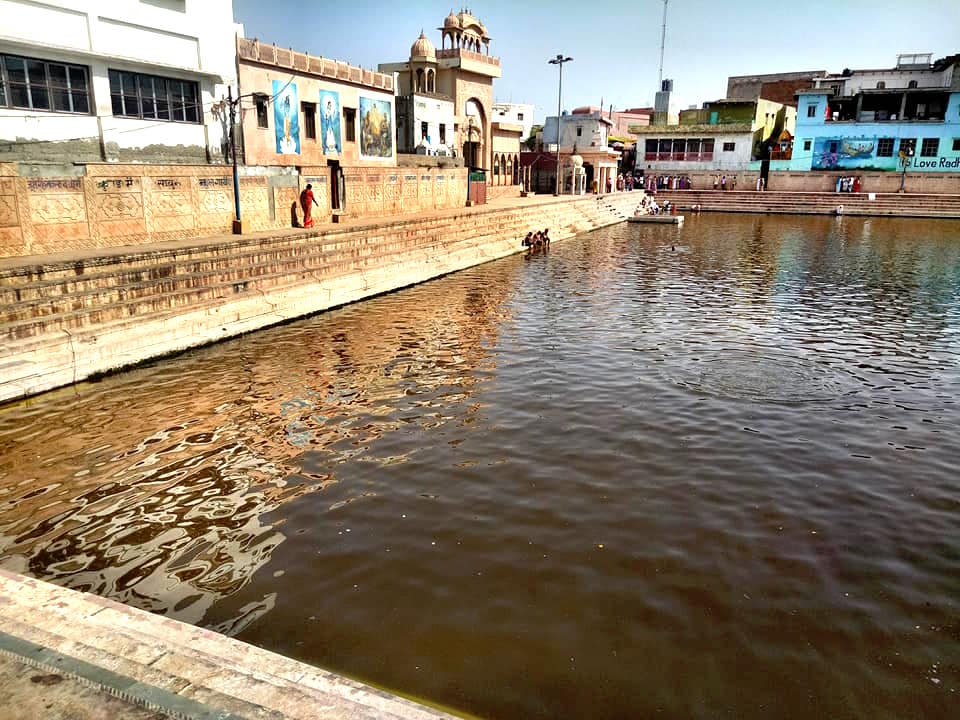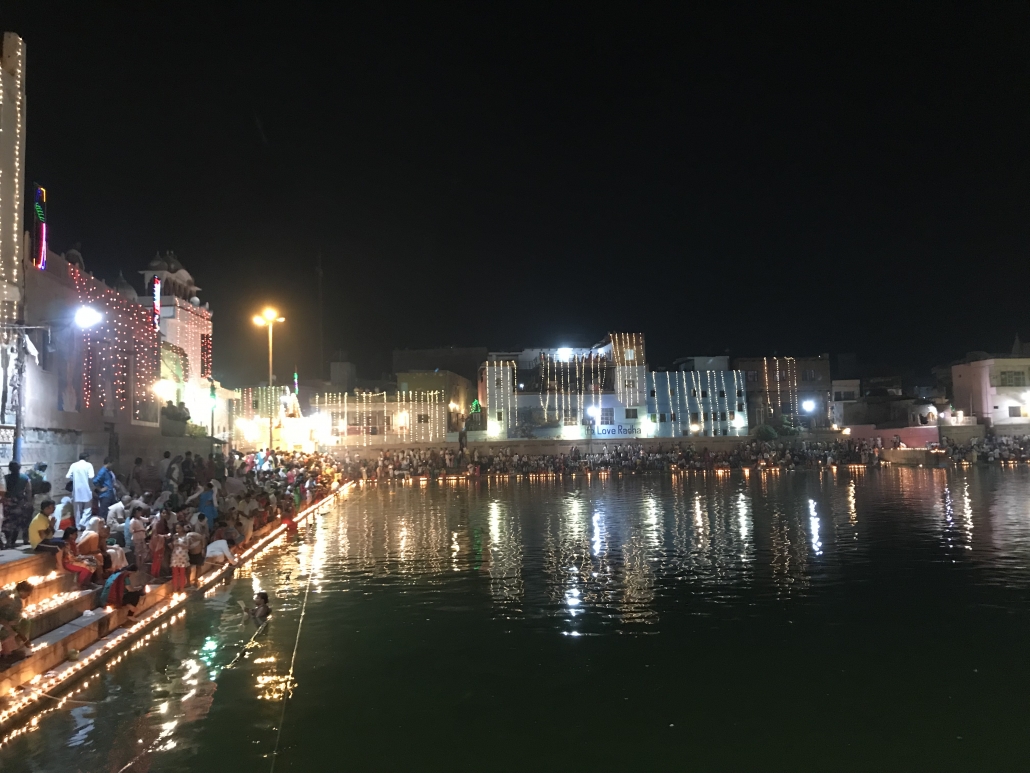Mahanidhi Madan Gopal Das
Herein we present a continuous sweet selection of tikas from the great rasika-acarya, Sri Jiva Goswamipada’s Krishna prema-filled comments on the Venu-gita (Srimas Bhagavatam 10.21). By reading and studying these comments along with the verses of Venu-gita, you will attain a happy feeling in your heart, and renewed enthusiasm to love and serve Radha and Krishna more and more. Jai Jai Sri Radhe!
10.21.15 Translation:
Vraja-gopis: When the rivers hear the flute-song of Krishna, the flow of their currents is broken and their waters are agitated out of desire, moving around in whirlpools. Presenting offerings of lotus flowers with the arms of their waves, the rivers grasp Murari’s lotus feet, covering them in their embrace.
Sri Jiva Goswamipada tika:
Unable to hide their emotions as previously, the Vraja-gopis attribute their emotions to an inanimate object out of intensity of attraction in attempting to describe their rasa.
The Vraja-gopis say, “The water bodies like Yamuna and Manasa-ganga come close and listen with attention (upadharya) to the attractive sound of Krishna’s flute. That song, having a raga of the highest bliss, frees one from all suffering. They offer lotuses in their waves acting as arms.
“They grasp Murari’s feet with their waves. Then they embrace Krishna surrounding him with water up to Krishna’s chest by increasing the flow of water. The rivers are most fortunate and we are not, because we cannot stop our course of household duties.
“We do not have many long arms by which we can embrace even one of Krishna’s feet to our breasts. The truth is this. When Krishnachandra plays His flute song, dry branches blossom, rocks melt and rivers stop flowing. When the water stops, the rivers swell and their waves overflow with lotuses, touching Krishna’s lotus feet.”
Seeing this, the gopis see the rivers as conscious entities.
10.21.16 Translation:
Vraja-gopis: In the company of Balarama and the cowherd boys, Krishna plays his flute loudly as he herds all the animals of Vraja, even under the full heat of the summer sun. Seeing this, the cloud in the sky expands himself out of love, rises high and constructs out of his own body, with its multitude of flower-like droplets of water, an umbrella for the sake of his friend.
Sri Jiva Goswamipada tika:
In two verses the gopis conceal their emotions as previously. Not being able to conceal their emotions, they imagine emotions in unconscious entities in two previous verses. In this verse they hide their feelings by describing sakhya-rasa. The cloud sees by means of lightning as eyes (this phrase should be added).
In the very intense heat (atape), Krishna with the boys herds the many cows, for which plenty of grass is necessary. Since there are many boys, lots of shade is necessary. Krishna plays the flute loudly (udiryantam) in order to attract the clouds behind him (anu). Filled with prema, a cloud rises and increases in size, by means of water drops (kusumavalibhih).
The Vraja-gopis say, “The cloud is a friend to Krishna because he is the same color. The cloud makes an umbrella out of his body. That umbrella is made of water droplets. Out of friendship, the cloud offers his own body or treasure. The cloud is most fortunate and we are unfortunate since we cannot even see him sufficiently.
“The truth is this. When they herd the cows in the heat, Krishna’s friends become tired and the cows begin to wander restlessly. At that time, Krishna plays on his flute the mallara-raga (named after the clouds) to attract the clouds.
“In the company of Balarama and the cowherd boys, Krishna plays his flute loudly as he herds all the animals of Vraja, even under the full heat of the summer sun. Seeing this, the cloud in the sky has expanded himself out of love, rises high and constructs out of his own body, with its multitude of flower-like droplets of water, an umbrella for the sake of his friend.”
10.21.17 Translation
Vraja-gopis: “The aborigine women of the Vrindavan become disturbed when they see the grass marked with reddish kumkuma powder. Endowed with the color of Krishna’s lotus feet, this powder originally decorated the breasts of his beloved, and when the aborigine women smear it on their faces and breasts, they feel fully satisfied and give up all their anxiety.”
Sri Jiva Goswamipada tika:
The Vraja-gopis now describe their own rasa by a verse revealing their emotions. The sequence is as follows. What to speak of his friend the cloud having good fortune, what can we say about the outcaste women? These women have reached success (purnah). We also can have a relationship with Krishna, but not with such good fortune as they! We are more lamentable than these outcaste women.
Krishna is called Urugaya because he sings expansively (uru) using his flute, which causes the gopis’ unsteadiness.
Vraja-gopis: Our minds desire to touch those lotus feet colored with beautiful, charming (sri) kumkuma. That kumkuma was on the breast of his lover. It is impossible for such gallant boy not to have a lover. We conclude that this kumkuma attained its beauty by being on the breasts of that dear lover kept secretly. But her good fortune filled with pastimes is far, far away from us.”
Sri Jiva Goswamipada tika:
The Vraja-gopis become agitated on seeing that kumkuma. Immediately just by seeing something related to Krishna, they become bewildered, by their nature or by remembering his pastimes. What to speak of when they actually see Krishna.
Vraja-gopis: That kumkuma has colored the grass. Let us take such a birth! Ah! Those women must be filled with bliss. Attracted by the kumkuma’s nature of creating greed, the Pulinda women bring it to their faces to smell it and see it. They then smear it on their faces and then on their breasts out of lust.
On seeing an object which is related to their lover, they desire association of even that object. By that object the pain caused by their desire becomes relieved to some extent. That gave them some relief, but we have no relief at all. Thus, they are perfect, whereas we are unfortunate.
Sri Jiva Goswamipada tika:
Something should be said in this regard. The Vraja-gopis’ words may be taken as an expression of their emotions since their deep emotions were caused simply by seeing Krishna from a great distance.
The kumkuma from the breast of one gopi was on Krishna’s feet. By describing that kumkuma as sri the gopis indicate that the gopi was special. It is understood that this is Radha.
The meeting between Radha and Krishna was possible during the day, since the Pulinda women were wandering about and it was still fresh since they could smear it on their faces and breasts. However, Radha and Krishna’s meeting was not intimate since it is said at the rasa pastimes was their first meeting.
One time Radha fainted because of attraction to Krishna’s flute. To relieve her of fainting, Krishna reverently touched Radha’s kumkuma covered breast with a flower petal which had touched his foot. This being the first time Krishna touched Radha, he then left quickly since Krishna was still feeling shy.
In speaking this verse, the Vraja-gopis all indicate that they have purva anuraga (attraction before directly meeting Krishna). Because there is absence of envy, even if another gopi has association, it only doubles their attraction.
10.21.18 Translation:
Of all the servants, Govardhana Hill is the best! O sakhis! This hill, blissful with the touch of the feet of Krishna and Balarama, along with their calves, cows and cowherd friends, gives respect with all kinds of necessities—water for drinking, honey, very soft grass, caves, bulbs and roots.
Sri Jiva Goswamipada tika:
In talking about other subjects in Vraja, the gopis hide their emotions by other rasas in two verses. They point out Govardhana (ayam) with their fingers, since they live near Govardhana. Hari indicates that Krishna steals away all the sins, suffering and hearts of everyone in the universe.
That he is the presiding deity is famous in scriptures and local lore. Govardhana is the best servant among all Krishna’s natural servants. His superiority is shown by the fruits he yields. He feels great joy at the touch of their feet, with hairs standing on end, perspiration, and tears by sprouting shoots and flowing with water drops.
He gives respect elaborately (vi—tanoti) in the form of all items. Paniya refers to water, honey, waterfalls, and pleasant places for sitting. Kandara refers to caves, equipped with jeweled beds, chairs, lamps and mirrors. With these items Govardhana serves Krishna and the others.
O young women with no strength, abala! Because you do not have strength you do not have the good fortune to serve. This is our great misfortune.
As in their first verse, the gopis hide their feelings but another meaning becomes evident. Amarakosh says that rama means blue, beautiful and white. Thus, Giriraj becomes joyful with the touch of the feet of Krishna, who is most beautiful (rama).
Tayoh verse can mean Govardhana gives joy to Krishna’s two feet by makes the stones appropriately warm or cool according to the season. Or Govardhana takes pleasure in supplying (sparsha) opportunities for playful (rama) Krishna’s activities (carana). Amarakosh says sparshana can mean giving. Govardhana is always anxious to encourage Krishna’s pastimes.
Or, Govardhana gives bliss to Krishna, us and the world by supplying opportunities for Krishna’s pastimes. Or, the touch of Govardhana is pleasurable like the touch of Krishna’s feet. By touching Govardhana, one accomplishes the bliss of touching Krishna’s feet, since he holds a treasure of the touch of Krishna’s feet as Krishna constantly performs various prema-filled lilas at that Govardhana.
Text 10.21.19 Translation:
My dear sakhis! As Krishna and Balarama pass through the forest with Their cowherd friends, leading Their cows, They carry ropes to bind the cows’ rear legs at the time of milking. When Krishna plays on His flute, the sweet music causes the moving living entities to become stunned and the nonmoving trees to tremble with ecstasy. These things are certainly very wonderful.
Sri Jiva Goswamipada tika:
What can be said about the glory of Govardhana, aptly named his best servant. But most fortunate are all the moving and non-moving beings there. Since Krishna must travel far because of the unlimited number of cows, he gives joy to all the living beings over a wide area. The gopis feel most unfortunate, being cheated of seeing Krishna.
The suffix ka on gopakaih indicates mercy since the boys are objects of Giridhari’s mercy, being part of Krishna’s family. The word gopa also indicates that they protect Krishna from places where there is fear and sorrow. But we gopis are not qualified to perform such service. The two boys wander at their leisure from forest to forest (nayatoh), but we do not have that fortune.
That flute is generous (udara), giving the highest joy to them all. That flute sound is special, producing soft, sweet tones (kala-padaih). The sound is attractive because of its sweetness. Because of its softness, it seems to be sending some hidden message.
Being filled with many emotions, it becomes most excellent. Or that sound becomes mixed with the footsteps (padaiù) which make sounds because of Krishna’s ankle bells. This indicates that the Vraja-gopis remember Krishna’s pastimes.
All those who have bodies (tanu-bhrteshu) fall under Krishna’s control. O sakhis, you know this. The rope refers to two pieces of cloth decorated with flower clusters and pearls placed on top of a turban on Krishna’s head. Though Krishna’s cowherd dress is attractive to all, it is especially attractive, enchanting and astonishing (vicitram) to the young gopis.
The verse indicates the Vraja-gopis complete absorption in Krishna as previously. O friends! Very clearly on the pretext of herding the cows Krishna wanders in the forest with his friends and brother and appears like a cheater. Krishna is a powerful flute player with attractive, invisible notes like a bewitching mantra.
Krishna is thus the chief cheater. The others follow him. Therefore, like us, you gopis should not hear Krishna’s flute filled with a bewitching spell. Otherwise, your minds will be bound up by Krishna’s two binding ropes. In this way they express their sorrow at being completely bewildered.
Venu-gita ki jai! Sri Jiva Goswamipada ki jai!
Radha-Govinda Yugala ki jai! Jai Jai Sri Radhe!



